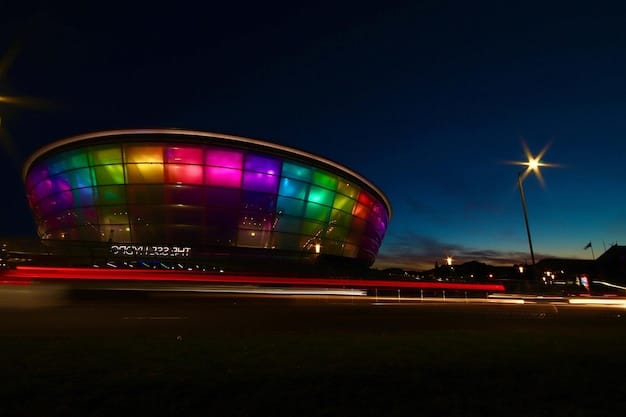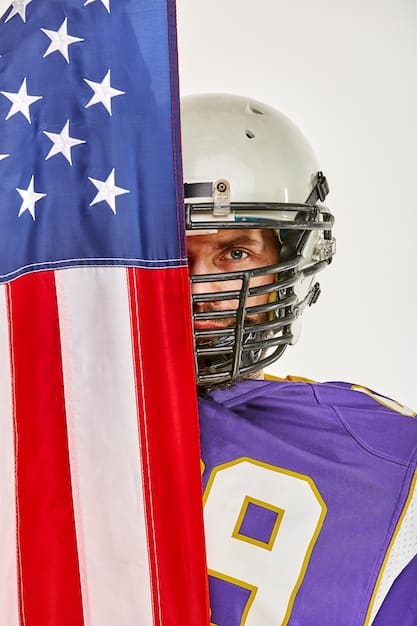US Soccer Rivalries: A Deep Dive into Heated Matchups

American soccer, experiencing a surge in popularity and fierce competition, is defined by its intense rivalries, which fuel fan passion and create memorable matchups across Major League Soccer and international play, demonstrating a rich tapestry of compelling narratives and sporting drama.
The landscape of American soccer has evolved dramatically, transforming from a niche interest into a vibrant, burgeoning sport with a passionate following. Central to this evolution are the rivalries—the intense, often bitter, contests that captivate fans and define eras. This article offers a comprehensive exploration into the most heated matchups in US soccer, delving into the factors that ignite these rivalries and their enduring impact on the sport. From historic clashes to emerging power struggles, we uncover the narratives that make US Soccer Rivalries: A Deep Dive into the Most Heated Matchups such a compelling aspect of the game.
the evolution of US soccer rivalries
The journey of professional soccer in the United States has been marked by waves of growth, decline, and resurgence. Early attempts at establishing leagues often faltered, but the persistent dream of making soccer a mainstream sport eventually took root. As the sport gained traction, particularly with the establishment of Major League Soccer (MLS) in 1993, rivalries naturally began to form, driven by proximity, historic results, and cultural distinctions.
Initially, these rivalries were often organic, stemming from regional pride or early playoff encounters. Over time, as team identities solidified and fan bases grew, these nascent rivalries blossomed into intense spectacles. The MLS, learning from other sports leagues and international soccer traditions, strategically fostered these narrative threads, understanding that passionate rivalries are essential for fan engagement and league growth.
foundational rivalries in early MLS
The early years of MLS saw the emergence of key rivalries that laid the groundwork for future intensity. These were often based on geographical proximity, creating natural derbies that resonated with local fans. These initial clashes were crucial in establishing emotional connections between teams and their communities, helping to build loyal followings.
- California Clasico (LA Galaxy vs. San Jose Earthquakes): One of the league’s oldest and most enduring rivalries, born from the start of MLS.
- I-5 Derby (Seattle Sounders FC vs. Portland Timbers): A Pacific Northwest clash with deep roots tracing back to the NASL era.
- Texas Derby (FC Dallas vs. Houston Dynamo): Representing the fierce sporting pride of the Lone Star State from the mid-2000s.
These early rivalries were characterized by hard-fought matches and a raw, passionate energy. They lacked the historical depth of European derbies but quickly made up for it with sheer intensity and a developing narrative. The players and coaches, many new to the unique atmosphere of MLS, soon understood the significance of these games to the fans.
The league’s expansion also played a pivotal role, introducing new teams and therefore new potential rivalries. As more cities gained MLS franchises, the tapestry of rivalries grew richer and more complex. Each new team brought its own local pride and fan culture, eager to establish dominance over neighboring or historically significant clubs. This expansion dynamic continues to shape the competitive landscape of US soccer.

major league soccer’s fiercest contests
MLS, now a mature and influential league, boasts some of the most dynamic and fervent rivalries in American sports. These aren’t just games; they are events, drawing massive crowds and generating significant media attention. The intensity often spills over from the pitch into the stands, creating an electrifying atmosphere that makes these matches must-see television and bucket-list experiences for fans.
The longevity of a rivalry often depends on consistent competitive balance, where both teams have their moments of glory and heartbreak. This back-and-forth narrative keeps the stakes high and prevents any single team from dominating the head-to-head record for too long, thus maintaining the competitive tension that fuels these heated encounters.
el trafico: the los angeles derby
Few rivalries have captured the imagination of MLS fans quite like El Tráfico, the clash between LA Galaxy and Los Angeles FC (LAFC). Despite its relatively recent inception in 2018, this rivalry quickly ascended to legendary status due to constant high-scoring thrillers, dramatic finishes, and the star power on both sides. The contrasting styles and fan bases of the two clubs add layers to the narrative.
LA Galaxy, the league’s most decorated club, represents the established guard, with a history of international superstars and championship pedigree. LAFC, on the other hand, burst onto the scene with a modern, attacking philosophy and an immediate desire to assert dominance in the city. This juxtaposition of old money versus new blood, combined with the presence of global soccer icons, ensures that every El Tráfico match is a spectacle.
the cascadia cup: sounders, timbers, and whitecaps
The Cascadia Cup, contested between the Seattle Sounders FC, Portland Timbers, and Vancouver Whitecaps FC, is a rivalry steeped in history, predating MLS by decades. Originating in the North American Soccer League (NASL), this three-way battle for regional supremacy is characterized by passionate, often hostile, fan engagement and fierce on-field battles. Each match is a chapter in a long, storied narrative.
- Unmatched Fan Intensity: Supporters travel in huge numbers, creating vibrant away sections and intense home atmospheres.
- Historic Roots: The rivalry extends beyond MLS, connecting to earlier eras of professional soccer in the region.
- Trophy at Stake: Teams compete not just for league points but for the Cascadia Cup itself, adding tangible stakes.
The geographical closeness of these teams only intensifies the rivalry, allowing for easy travel for away supporters and fostering direct interaction between fan bases. The beautiful scenery of the Pacific Northwest serves as a backdrop to some of the most compelling and dramatic sporting contests in US soccer, making the Cascadia Cup a true highlight of the MLS season calendar.
intracity battles: local pride on the line
Intracity rivalries are the lifeblood of many sports leagues, and MLS is no exception. These contests pit neighbors against neighbors, generating immense local pride and bragging rights. The stakes feel personal, as players often live in the same communities as the fans, and the results directly impact daily life in the city. The tension is palpable, not just in the stadium, but in the streets, workplaces, and homes of the competing fan bases.
The beauty of intracity rivalries lies in their intimate nature. Fans don’t just dislike the opposing team; they dislike their fans, their neighborhoods, and their perceived attitudes. This deep-seated animosity, while sporting in nature, adds an undeniable edge to every encounter, making these games crucial beyond just points in the standings. It becomes about identity, belonging, and local supremacy.
new york derby: red bulls vs. city fc
The New York Derby between the New York Red Bulls and New York City FC (NYCFC) is a classic tale of old guard versus new money, with a geographical twist. The Red Bulls, established in MLS since its inception, represent the traditional soccer presence in the New York metropolitan area, playing across the Hudson River in New Jersey. NYCFC, a newer entrant backed by Manchester City’s owners, brought a glitzy, modern appeal and a stadium in the heart of New York City.
This dynamic has fueled intense clashes, often characterized by strong attendance and lively banter between fan groups. The Red Bulls often play the role of the gritty, underdog team from outside the city limits, while NYCFC embodies the aspirations and flash of a global brand. The contrast in styles, fan demographics, and foundational philosophies creates a compelling narrative for every derby match, making it a must-watch event for fans across the tri-state area.
flair and rivalry: orlando vs. atlanta
The burgeoning rivalry between Orlando City SC and Atlanta United FC quickly became one of the most exciting in the league. Both teams represent major expansion successes for MLS, boasting massive fan bases, passionate atmospheres, and a flair for attacking football. The geographical proximity, combined with the rapid ascendance of both clubs, fueled an intense competition for regional dominance in the Southeast.
- Explosive Fan Bases: Both clubs are renowned for their highly vocal and dedicated supporters, creating electrifying stadium environments.
- Offensive Firepower: Matches between these two often feature high-scoring affairs and exciting, end-to-end action.
- Playoff Implications: Regular season encounters frequently have significant implications for playoff positioning, adding an extra layer of intensity.
The rivalry is less about ancient history and more about current competitive balance and stylistic clashes. Each match is a battle for regional bragging rights, with both teams eager to prove their superiority in what is fast becoming a hotbed of US soccer talent. The atmosphere in their respective stadiums, with loud chants and vibrant TIFOs, perfectly encapsulates the modern, energetic spirit of MLS derbies.
national team rivalries: usa vs. the world
While club rivalries provide a consistent narrative throughout the MLS season, national team rivalries ignite a different, perhaps even deeper, level of patriotism and passion. When the US Men’s National Team (USMNT) or Women’s National Team (USWNT) takes the field against certain opponents, the matches transcend sport, becoming symbolic battles for national pride. These international contests are often infused with historical context, political undertones, and dramatic moments that resonate with fans across the entire country.
The stakes are amplified in these games, as qualification for major tournaments like the World Cup hangs in the balance. Every tackle, every pass, every goal is scrutinized, and the emotional investment from the fans is immense. These rivalries shape the identity of American soccer on the global stage, proving the team’s mettle against long-standing adversaries and new challengers alike.

usa vs. mexico: the biggest rivalry
Undoubtedly, the rivalry between the US men’s national team and Mexico is the most significant and storied in CONCACAF, if not all of North American sports. Rooted in geographical proximity, historical immigration patterns, and cultural pride, this rivalry is more than just a soccer match; it’s a proxy battle for regional supremacy. Matches between the two nations are often referred to as “Dos a Cero” by US fans, a nod to the frequent 2-0 scoreline in favor of the USA at home. The competitive nature of this rivalry has been a key factor in the development and growth of soccer in both countries.
The intensity is fueled by passionate fan bases that often mix in stadiums, creating a vibrant, dual-language atmosphere. Players on both sides understand the magnitude of these games, knowing that a win against their fiercest rival carries immense bragging rights and can define a generation. This constant back-and-forth, with both teams enjoying periods of dominance, ensures the rivalry remains fierce and compelling, making every encounter a must-watch event for soccer fans across the continent.
usa vs. canada: a growing rivalry
While not possessing the same historical depth as the Mexico rivalry, the developing rivalry between the USA and Canada is gaining significant traction, particularly with the recent competitive rise of both nations. Both the men’s and women’s teams have seen their profiles elevated, leading to increasingly impactful and intense matchups. For the women’s teams, the rivalry has long been a fiercely contested affair, with both sides frequently among the world’s elite. For the men’s, Canada’s recent surge in World Cup qualification has injected new life into the contests, transforming them from routine fixtures into genuine battles for CONCACAF supremacy.
These matches are now often characterized by physical play, tactical battles, and dramatic moments. As both countries continue to invest in soccer development and produce top-tier talent, the rivalry is poised to grow even more heated, adding another compelling layer to the US national team’s competitive landscape. The shared border and cultural connections only serve to deepen the narrative, as battles for regional bragging rights intensify.
the impact of fan culture on rivalries
Fan culture is an indispensable element in shaping and sustaining soccer rivalries. Beyond the 90 minutes on the pitch, the supporters’ groups, their chants, their TIFOs, and their unwavering loyalty create the backdrop against which these epic battles are played out. The passion of the fans transforms a regular game into an emotional spectacle, injecting energy and meaning that extends far beyond the final score. It’s the fans who provide the constant narrative, the historical memory, and the emotional investment that fuels the competitive fire between clubs and nations.
The unique traditions and expressions of each fan base contribute significantly to the identity of a rivalry. Whether it’s the drums and smoke bombs of an MLS supporters’ section or the coordinated chants of a national team crowd, the collective energy of the fans is what truly elevates these matches. Their dedication often dictates the atmosphere, the intensity, and even the emotional swings of the game itself, making them active participants in the drama.
supporters’ groups: the heartbeat of rivalry
In US soccer, organized supporters’ groups play a pivotal role in cultivating and escalating rivalries. These groups create elaborate displays, coordinate chants, and dedicate significant time and resources to supporting their teams. They are often the ones who keep the flame of a rivalry burning, even when teams might be experiencing periods of uneven performance. Their passion is infectious, drawing in casual fans and turning them into fervent supporters.
- Choreographed Displays: Producing large-scale banners (TIFOs) and smoke displays that often mock rivals.
- Constant Chants: Creating unique songs and chants, often directly aimed at taunting the opposing team and its fans.
- Organized Away Travel: Ensuring a strong presence at away derbies, making their voices heard in rival territory.
These groups don’t just support their own team; they actively engage with the opposition, adding a layer of strategic psychological warfare to the matches. The back-and-forth between rival supporters’ sections is often as entertaining and intense as the play on the field, defining the character of the rivalry and driving fan engagement to new heights. Their commitment ensures that these rivalries continue to evolve and capture new generations of fans.
the role of social media in fan rivalries
In the digital age, social media has become an amplified arena for soccer rivalries. Platforms like Twitter, Instagram, and Facebook allow fans to engage in real-time banter, express their allegiances, and celebrate victories (or commiserate losses) with unprecedented reach. This constant online interaction keeps the rivalry alive 24/7, even when teams aren’t playing each other. Social media becomes a space for pre-match hype, in-game reactions, and post-match gloating, extending the lifespan of emotions tied to these contests.
While social media can sometimes amplify negative aspects, it predominantly serves to deepen connections among fans of the same team and intensifies the friendly (and not-so-friendly) competition with rival supporters. This digital extension of fan culture plays a crucial role in maintaining the narrative of long-standing rivalries and helping new ones quickly gain traction. The viral nature of memes, fan videos, and direct exchanges ensures that the energy of rivalry permeates beyond the stadium walls, reaching a global audience.
the future of us soccer rivalries
The landscape of US soccer is dynamic, constantly evolving with expansion teams, new player acquisitions, and changing competitive dynamics. This evolution naturally leads to the birth of new rivalries and the resurgence of old ones. As MLS continues to grow and gain prominence, and as the US national teams solidify their positions on the world stage, the intensity and importance of these rivalries will only increase. The future promises more dramatic moments, more passionate fan displays, and a deeper integration of soccer into the American sporting consciousness.
New cities entering the league bring with them fresh fan bases eager to establish their own identities and assert dominance over existing clubs. This competitive pressure, combined with the strategic scheduling of “rivalry weeks” by the league, ensures that the spirit of competition remains at the forefront. The ongoing success of both men’s and women’s national teams also means that international rivalries will continue to be compelling narratives, shaping the nation’s soccer story.
emerging rivalries and expansion teams
The continuous expansion of MLS brings new metropolitan areas into the fold, each presenting opportunities for fresh rivalries. Teams like St. Louis City SC and Charlotte FC have rapidly developed passionate fan bases, eager to compete against established clubs and their regional neighbors. These new additions infuse the league with new energy, fresh faces, and unique local narratives that quickly translate into on-field competitive tension.
- St. Louis City SC vs. Sporting Kansas City: A Midwest connection with potential for fierce battles for regional supremacy.
- Charlotte FC vs. Atlanta United FC: A Southeast derby in the making, building on fan passion and geographical proximity.
As these new teams find their footing and develop their own histories, the rivalries involving them will grow in depth and intensity. The influx of new talent, charismatic leaders both on and off the field, and dedicated fan groups will ensure that the spirit of competition remains vibrant. These emerging rivalries are crucial for the continued growth and diversification of the league, ensuring that the competitive fires burn brighter than ever before.
the role of competition and success
Ultimately, sustained competition and mutual success are the true engines of enduring rivalries. When two teams consistently contend for championships, face each other in crucial playoff matchups, or play in games with significant league implications, the intensity of their rivalry naturally deepens. The shared history of triumph and heartbreak, of memorable goals and controversial decisions, welds itself into the fabric of the clubs’ identities and their shared narrative.
This competitive balance fosters a healthy tension, ensuring that neither team ever completely dominates the other for too long, thus maintaining the emotional investment from the fans. Both club and national team rivalries benefit from this dynamic; the more competitive the games, the higher the stakes, and the more memorable the encounters become. As US soccer continues its upward trajectory, the quality and stakes of these rivalries will only continue to rise, captivating audiences and solidifying the sport’s place in the American sporting landscape.
| Key Rivalry | Brief Description |
|---|---|
| ⚽ USA vs. Mexico | The most significant and historically charged national team rivalry in North America, embodying regional soccer supremacy. |
| 💥 El Tráfico | LA Galaxy vs. LAFC, a modern MLS classic known for high-scoring, dramatic matches and star power. |
| 🌲 Cascadia Cup | Seattle Sounders, Portland Timbers, and Vancouver Whitecaps in a historic, passionate Pacific Northwest derby. |
| 🗽 New York Derby | New York Red Bulls vs. NYCFC, a tale of traditional and modern soccer in the heart of the Big Apple. |
frequently asked questions about US soccer rivalries
▼
Heated rivalries in US soccer often stem from a combination of geographical proximity, historical matchups that include high-stakes games or controversial moments, and contrasting team philosophies or fan cultures. Passionate fan bases that actively engage in banter and support their teams vehemently also play a crucial role in amplifying the intensity.
▼
While MLS rivalries may not have the centuries of history some European or South American derbies possess, they compensate with intense passion, rapid growth, and often a distinctly American flair. They share the same core elements of local pride and competitive desire, and are quickly building their own rich traditions and iconic moments that resonate deeply with fans.
▼
Yes, the USA vs. Mexico rivalry remains the most significant and iconic matchup for the US Men’s National Team. Its deep historical roots, cultural implications, and constant high stakes (often with World Cup qualification on the line) make it unparalleled. While other rivalries are emerging, none carry the same weight or generate the same level of pervasive national interest.
▼
Fan groups are integral to rivalries by creating vibrant atmospheres with chants, TIFOs, and organized support. They maintain the narrative and emotional investment, often engaging in direct banter with rival fans. Their unwavering dedication keeps the spirit of the rivalry alive, both in the stadium and through social media, extending its reach and impact far beyond match day.
▼
As MLS expands, new rivalries naturally emerge. Notable examples include St. Louis City SC vs. Sporting Kansas City in the Midwest and Charlotte FC vs. Atlanta United FC in the Southeast. These are fueled by geographical proximity and the rapid development of passionate new fan bases, promising intense future matchups and adding fresh dynamics to the league’s competitive landscape.
conclusion
The fabric of US soccer is undeniably woven with the threads of its most heated rivalries. From the long-standing national team clashes that transcend sport to the passionate regional and intracity battles that define MLS, these rivalries are more than just games; they are cultural phenomena. They generate immense joy, profound heartbreak, and unforgettable moments that captivate fans and drive the sport’s burgeoning growth. As American soccer continues its impressive ascent, these fierce contests will remain at its heart, promising even more thrilling chapters and cementing soccer’s place as a major player in the US sporting landscape. The intensity, the narratives, and the sheer passion involved in these matchups highlight why they are so vital to the very essence of American soccer.





